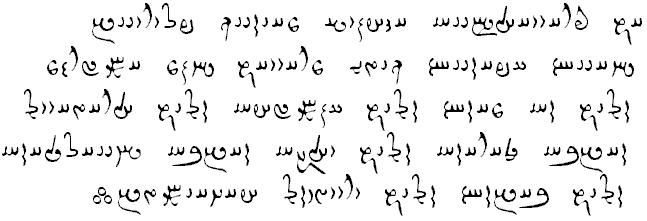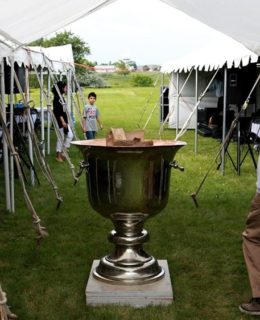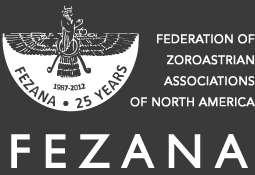
A | B | C | D | E | F | G | H | I | J | K | L | M | N | O | P | Q | R | S | T | U | V | W | X | Y | Z
N
OAv. – Old Avestan, Av. – Avestan, OP. – Old Persian, Phl. – Pahlavi (Middle Persian), NP. – New Persian (Modern Persian “Farsi”), PGuj. – Parsi Gujarati, Skr. – Sanskrit, Ar. – Arabic, Lat. – Latin
| Entries | Etymology | Definitions |
| nabor | It is practiced four days in a month. Is about protecting domestic animals such as cows, chicken, etc. since on these days people do not consume meat. | |
| Nahavand | NP. nahāvand | Battle between Sasanians and Arabs (major victory for the Arabs) which marked the collapse of the Sasanian Empire – 642 C.E. (see Qadisiyya). |
| nahn | Av. snā– | Ritual bath for purification, performed before Sedreh-pooshi/Navjote, wedding and on the fortieth day after giving birth. It may also refer to the period of seclusion after taking the Bareshnum. |
| najes | Ar. najis | Arabic term referring to anything that is impure. |
| nask | Av. naska-; Phl. nask | Lit. bundle – It refers to the 21 collections of Avestan texts. With only one surviving till date. Believed to be given to Zarathustra by Ahura Mazda. |
| nasu | Av. nasu-; Phl. nasuš | Dead matter. |
| navar | Phl. nāwar | First grade of ordination as a priest. |
| navjote | Phl. nōg + zōtīh/zādīh | The Gujarati term for initiation. (See also nowzoodi and Sedreh-pooshi). |
| Neriosang Dhaval | Av. nairiiō.saŋha-; Phl. nēryōsang | 1. High Priest from Iran who arrived in Sanjan and approached King Jadav Rana for refuge. 2. It may also refer to the 15th century priest by the same name, responsible for translating a number of texts into Sanskrit. |
| niayesh | Phl. niyāyišn | Short devotional prayer to (fire, water, sun, and the moon). |
| nirang | Phl. nērang | 1. Libation: consecrated bull’s urine used for purification in nahn ceremonies of the navjote, wedding and bareshnum. 2. A powerful, mystical, formulaic prayer (Ardibehest Yasht Nirang, Sarosh Yasht Nirang). |
| nirang-din/nirangdin | Phl. nērang + dēn | Ceremony to consecrate ‘taro’ (unconsecrated bull’s urine). |
| noghl | NP. noql | Candied nuts. |
| Nowruz/Norooz/Navroz | Phl. nōg rōz; NP. nowruz; PGuj. navroz | Lit. ‘new day’, This refers to the New Year, which is celebrated by Zoroastrians at the time of the Spring equinox. *Please note that we have listed the most common versions that can be read in English. |
| Nowzar/Nauzer | Av. naotara-; Phl. nōdar | Ninth Peshdadian king, son of Manuchehr. |
| nowzoodi | Phl. nōg + zōtīh/zādīh; NP. nowzudi | 1. Lit. New life, new birth. 2. Process of becoming of an ordained priest in Iran. (See navjote) |
O
OAv. – Old Avestan, Av. – Avestan, OP. – Old Persian, Phl. – Pahlavi (Middle Persian), NP. – New Persian (Modern Persian “Farsi”), PGuj. – Parsi Gujarati, Skr. – Sanskrit, Ar. – Arabic, Lat. – Latin
| Entries | Etymology | Definitions |
| Ohrmazd | Av. ahura- mazdā-; Phl. ohrmazd; NP. hormazd; PGuj. hormuzd | See Ahura Mazda, Hormuzd. |
| Ordibeheshtgan | Phl. ardwahištgān; NP. ordibeheštgān | Monthly celebration: day of Ordibehesht and month of Ordibehesht. See Ardibehesht/Asha Vahishta. |
P
OAv. – Old Avestan, Av. – Avestan, OP. – Old Persian, Phl. – Pahlavi (Middle Persian), NP. – New Persian (Modern Persian “Farsi”), PGuj. – Parsi Gujarati, Skr. – Sanskrit, Ar. – Arabic, Lat. – Latin
| Entries | Etymology | Definitions |
| padan | Av. paiti.dāna-; Phl. padām | Mouth covering worn by priest before the fire. |
| padyab | Av. paiti. ap-; Phl. padyāb | Washing of hands and face. |
| pagri | Hindi pagṛī | Turban worn primarily by priests. |
| Pahlavi | Phl. pahlawīg | Middle Persian language and script, used by the Sasanians for official inscriptions, and literature, including Zoroastrian texts. Zoroastrian books continued to be written in Pahlavi into the 10th century C.E. |
| paidust | The Zoroastrian funeral ceremony. | |
| Paitishahem gahanbar | Av. paitiš.hahiia- + Phl. gāhānbār | The third seasonal festival of the year. Mid-Spring festival, Apr 30 – May 4, month of Shehrevar, in honour of Earth (creation). |
| paivand | Phl. paywand | Ritual connection between priests and family members during a funeral, usually in the form of holding each other’s clothing or a shared handkerchief. |
| panchayet | Skt. pañca– | Governing body of 5 trustees appointed/elected e.g. Bombay Parsi Panchayet (BPP). |
| panthak | PGuj. pantha | 1. Lit. sector, group, or denomination, the leader of which is known as a panthaki or head priest (not to be confused with high priest or dastur). 2. Jurisdiction of a Parsi priest. |
| parab | PGuj. parva | 1. Lit. holiday or festival. 2. Used to refer to occasions when the Yazata/Ameshaspand of the day and month are the same. Its literal corresponding Pahlavi term is jashan. |
| Parsi/Parsee | OP. pārsa-; Phl. pārsīg | A Zoroastrian who is descended from those who left Iran around the 9th or 10th century CE, to settle in north-west India. |
| Patet Pashemani | Av. paitita-; Phl. patit + pašēmānīh | Prayer of repentance. |
| Pateti | Phl. patitīg | Observed on the eve of the Zoroastrian New Year (time of repentance and reflection). |
| patlo | 1. Gujarati term for a wooden platform 3-4 inches high used to stand on during Sagan (blessings). 2. Used by the child/initiate to stand on during the navjote ceremony. | |
| pavi | Phl. pad + āb | Consecrated area for ceremonies in the fire temple marked by a groove/furrow in the floor. It usually remarks the boundary of the Kebla or Urvish Gah and also serves as a means of draining the water used in washing the ritual areas. |
| payman-e-din | Phl. paymān + dēn | One of the kushti prayers. |
| Pazand/Pazend | Phl. pāzand | Middle Persian texts transcribed into Avestan script (Pahlavi written in Avestan alphabet). |
| Peshdadian/Pishdadian | Phl. pēš + dād | The first mythological dynasty of Iranian kings in the Shah Nameh. |
| Pir-e-Herish | Phl. pīr | Shrines in Iran. |
| Pir-e-Naraki | Phl. pīr | Shrines in Iran. |
| Pir-e-Sabz | Phl. pīr | Shrines in Iran. |
| porseh | NP. porseh | Death ceremony/memorial service. |
| Pourdavoud | First one to translate the Avesta and Gathas into Modern Persian. Iranian professor of Linguistics. | |
| Pouruchista/Pouruchisti | Av. pourucištā– | Zarathushtra’s youngest daughter, wife of Jamasp. |
| Pourushaspa | Av. pourušaspa– | Father of Zarathushtra. |
Q
OAv. – Old Avestan, Av. – Avestan, OP. – Old Persian, Phl. – Pahlavi (Middle Persian), NP. – New Persian (Modern Persian “Farsi”), PGuj. – Parsi Gujarati, Skr. – Sanskrit, Ar. – Arabic, Lat. – Latin
| Entries | Etymology | Definitions |
| Qadisiyya Battle | Along with Nahavand, these were the two definitive battles that ended Sasanian rule in Iran and the start of the Islamic Invasion. |
R
OAv. – Old Avestan, Av. – Avestan, OP. – Old Persian, Phl. – Pahlavi (Middle Persian), NP. – New Persian (Modern Persian “Farsi”), PGuj. – Parsi Gujarati, Skr. – Sanskrit, Ar. – Arabic, Lat. – Latin
| Entries | Etymology | Definitions |
| Ram | Av. rāman-; Phl. rām | 1. Lit. Peace. 2. Name of a yazata. 3. Day of the month. 4. Name of one of the Yashts in the Avesta. |
| Rapithwan gah/geh | Av. rapiϑβā- + Phl. gāh | Second watch of the day, from noon till 3:00 p.m. Also a ceremony and celebration on Ardibehesht roz and Farvardin mah. |
| Rashne | Av. rašnu-; Phl. rašn | 1. Lit. Right order. 2. Day of the month. 3. Name of one of the Yashts in the Avesta. |
| ratu | Av. ratu-; Phl. rad | Religious teacher/leader. Also used to refer to Divine beings as spiritual lords in Avestan literature. |
| revayat/rivayats | Ar. rivāyat; NP. revāyat | Lit. instruction – the Persian Revayats were communications concerning the religion sent from Iranian Zoroastrians to Parsis between the late 15th and late 18th centuries. |
| Rostam/Rustam | NP. rostam | An eastern Iranian heroic figure, whose stories appear in the Shah Nameh. Iranian male name. |
| roz/roj/ruz | Av. raocah-; Phl. rōz; NP. ruz; PGuj. ruj, roj | Day. |
| Rudabeh | NP. rudābeh | Mother of Rostam in the Shah Nameh. |
| ruvan/ravan | Av. uruuan-; Phl. ruwān; NP. ravān | Lit. Soul. (See urvan) |
S
OAv. – Old Avestan, Av. – Avestan, OP. – Old Persian, Phl. – Pahlavi (Middle Persian), NP. – New Persian (Modern Persian “Farsi”), PGuj. – Parsi Gujarati, Skr. – Sanskrit, Ar. – Arabic, Lat. – Latin
| Entries | Etymology | Definitions |
| sabzeh | Phl. sabz; NP. sabz(i), sabzeh | Green (vegetables/herbs) – sprouted greens for Nowruz table. |
| sagan | PGuj. shagun | When the candidate is made to wear a garland, tilli, and given gifts of money. It is usually done on a raised platform known as a patlo and is performed by a priest or close family members for navjotes, weddings, birthdays and special occasions. |
| sal/varsi | Phl. sāl; NP. sāl; Skr. varṣa– | The one year death anniversary prayers. |
| Salm/Saam | Phl. salm | 1. Son of Nariman in the Shah Nameh 2. Iranian male name. |
| saoshyant | Av. saošiiaṇt– | A person who brings benefit to the world (Literal translation). In Zoroastrian mythology, the Saoshyant is a succession of three people, who will aid in the final defeat of evil and the renovation of the world at the end of time. |
| sapaat | Parsi Gujarati term for closed-toe, leather slippers worn by both priests and laity. Decorated ones are worn by children on the navjote. | |
| Sarosh vaj | Phl. srōš wāz; NP. soruš bāj; PGuj. saroš vāj | Prayer to untie the koshti in the Kadimi/Irani tradition. |
| Sarosh Yasht Hadokht | Phl. srōš yašt hādōxt | One of the two yashts devoted to Sarosh, named after the Hadokt. |
| Sasanian/Sassanian | Phl. sāsān | Last pre-Islamic, Iranian dynasty. |
| satum/stoom | Av. staoma-, staomi-; Phl. stōm; NP; stum; PGuj. satum | See stom. |
| Sedreh-pooshi | NP. sudreh pušidan; PGuj. sedre-pūšī | The Persian term for initiation. (See navjote) |
| ses | A round metallic tray with auspicious items used on joyous occasions. It usually contains a container for the vermillion paste, rose water and cone known as the soparo. It may also contain a coconut, and garland. | |
| setayesh | Phl. stāyišn; NP. setāyeš | Prayers of offerings and adoration. |
| Shah Nameh | NP. šāh nāmeh | Iranian national epic, composed by Ferdowsi, late 10th-early 11th century C.E. |
| Shahrivar/Shehrevar | Av. xšaϑra- vairiia-; Phl. šahrewar; NP. šahrivar | 1. Amesha Spenta responsible for metals and the sky. 2. Day of the month 3. Name of a month. |
| Shahrivargan | Phl. šahrewargān; NP. šahrivargān | Monthly celebration: day of Shahrivar and month of Shahrivar. |
| Shapur | Phl. šābuhr; NP. šāpur | Sasanian King, common male name. |
| Shenshai/Shahanshahi | Phl. šāhān šāh | 1. Lit. of the King of kings. 2. One of the three calendar conventions most commonly followed by the Parsi community. |
| Siamak | Av. siiāmaka-; Phl. syāmak; NP. siyāmak | Son of Gayomard (Kayomars) in the Shah Nameh. |
| Simorgh | Av. saēna- mərəγa-; Phl. sēn murw; NP. simorγ | Mythical bird in the Shah Nameh. |
| Siroja/See roozeh/Sirozeh/Disi | Phl. sīh rōzag; NP. siruzeh/sirozeh/sirojah | One of the prayers in the death ceremonies performed on the thirtieth day after passing. |
| Siroja/Sirozeh Yasht | Phl. sīh rōzag + yašt; NP. siruzeh/sirozeh/sirojah + yašt | Prayer unto the thirty-three yazatas. |
| Sistan | OP. sakastāna-; Phl. sagestān; NP. sistān | Province of Iran. |
| Siyavaksh/Siyavush | Av. siiāuuaršan-; Phl. s(i)yāwaxš; NP. siyāvuš | Heroic figure in the Shah Nameh. |
| Sizdeh Bedar | NP. sizdeh be-dar | 1. 13th day after Nowruz. 2. In Iran, families go on picnics and also throw the sabzi from the Haft Seen table into a body of water. 3. Some say this is a day of practical jokes and the origin of April Fool’s Day. |
| Sohrab | NP. sohrāb | Son of Rostam in the Shah Nameh. |
| Spendarmad/Sependarmazd | Av. (spəṇtā-) ārmaiti-; Phl. spandarmad; NP. aspandarmad, asfandarmad | (See Armaiti) |
| Spendarmazgan/Sependarmazgan | Av. (spəṇtā-) ārmaiti-; Phl. spandarmad; NP. aspandarmad, asfandarmad | Celebration of Spendarmad roz and mah; parab related to Spenta Armaiti. (See Armaiti) |
| spenta | Av. spəṇta– | ‘Bringing increase’. |
| Spenta Armaiti/Spendarmazd/Esfandarmad | Av. (spəṇtā-) ārmaiti-; Phl. spandarmad; NP. aspandarmad, asfandarmad | 1. The Avestan noun Spenta Armaiti has been translated to ‘serenity’ and ‘right-mindedness.’ 2. It is the name of one of the seven Amesha Spentas. 3. Day of the month. 4. Name of a month. |
| Spenta Mainyu | Av. spəṇta- mainiiu- | 1. Lit. Beneficent inspiration/spirit. 2. One of the Amesha Spentas connected to humans (creation) 3. Known in opposition to Angra Mainyu. |
| Spentamainyush/Spentomad | Av. spəṇtāmainiiu-; Phl. spandamen | (See Spentomad Gatha) |
| Spentomad Gatha | Av. spəṇtāmainiiu- gāϑā-; Phl. spandamen gāh | The third Gatha. Yasna Chapters 47-50. |
| Spitaman/Espantaman | OAv. spitāma-; YAv. spitama-; Phl. spitāmān | Family name of Zarathushtra. |
| Sraosha/Sorosh/Srosh/Soroush*/Sarosh | Av. sraoša-; Phl. srōš; NP. soruš; PGuj. saroš | 1. Lit. readiness to listen. 2. Day of the month. 3. Name of a yazata. (The writing of Soroush is due to the French influence of spelling /oo/ with <ou>) |
| Staot(a) Yasna | Av. staota- yesniia- | 1. Lit. to praise. 2. Refers to the Staot or ‘revered’ section of the Yasna starting with Ha 55. |
| stom | Av. staoma-, staomi-; Phl. stōm; NP; stum; PGuj. satum | Prayer recited over meals in honour of the dead. |
| sudreh/sedreh | Lat. sudarium? | The sacred cotton shirt worn by initiated Zoroastrians. |
| sukhad | Skr. sukhad | 1. Lit. giving pleasure 2. Fragrant, tropical softwood (usually sandalwood) used as a ritual offering. |
| supra nu murat/ni reet | PGuj. supra | 1. Lit. winnowing basket. 2. A ceremony to make and apply turmeric paste on the couple the day before the wedding. Four married women perform a winnowing ritual of auspicious items in four baskets, exchanging them in a circle around a mortar and pestle while singing. The metal mortar and pestle is used to make the turmeric paste applied on the bride or groom. |
T
OAv. – Old Avestan, Av. – Avestan, OP. – Old Persian, Phl. – Pahlavi (Middle Persian), NP. – New Persian (Modern Persian “Farsi”), PGuj. – Parsi Gujarati, Skr. – Sanskrit, Ar. – Arabic, Lat. – Latin
| Entries | Etymology | Definitions |
| Tahmuras/Tehmures/Tehmurasp | Av. taxma- urupi– | King from the Shah Nameh. |
| Takht-e Jamshid/Parseh | NP. taxt-e jamšid | Name of Persepolis in Persian. |
| Tandorosti | Phl. tan + drustīh | Prayer of well-being and good health. |
| Tansar/Tosar | Phl. tansar/tōsar | High priest under the Sasanian king, Ardashir I. |
| Taq-e-Bustan | NP. ṭāq-e bostān | Sasanian monument. |
| Tehran/Teheran | NP. tehrān | Modern capital of Iran. |
| tilli | Skr. tilaka | 1. Lit. mark. 2. A red line/dot made on the forehead with ‘kumkum’ (vermillion paste) on joyous occasions. |
| Tirgan/Tirangan | Phl. tīrgān; NP. tir(an)gān | Festival dedicated to Tishtriya, held in midsummer (parab). |
| Tishtriya/Tir | Av. tištriia-; Phl. tištar/tīr; NP. tir | 1. Water, rain, fertility. 2. Name of a yazata. 3. Day of the month. 4. Name of one of the Yashts in the Avesta. – associated with the star Sirius (Tishtriya). |
| Toor/Tur | Av. tūra-; Phl. tūr; NP. tur | Brother of Salm in the Shah Nameh. |
| topi | PGuj. topi | 1. Lit. hat/cap. 2. A velvet or cotton cap that covers all the hair. Worn by children/adults while reciting prayers or when attending religious ceremonies and rituals. |
| toran | Skr. toraṇa– | A flower or bead garland used to adorn doorways and entrances. |
U
OAv. – Old Avestan, Av. – Avestan, OP. – Old Persian, Phl. – Pahlavi (Middle Persian), NP. – New Persian (Modern Persian “Farsi”), PGuj. – Parsi Gujarati, Skr. – Sanskrit, Ar. – Arabic, Lat. – Latin
| Entries | Etymology | Definitions |
| Udvada | PGuj. udvāḍā | A village in Gujarat which is the seat of the Iranshah Atash Behram. |
| upasayaeni | Av. (dāitiiō.)upasaiieni.(bauu-) | An offering of a throne to the fire of either 6, 7, or 9 wood pieces. (See maachi) |
| urvan | Av. uruuan-; Phl. ruwān | Soul, spirit; one of the immortal constituents of a human, responsible for good and bad actions performed in the material world. |
| Ushahin gah/geh | Av. ušahina- + gāϑā-; Phl. ušahin gāh | The fifth/last watch of the day, from midnight till sun-rise. |
| Ushtavaiti/Ushtavad | Av. uštauuaitī-; Phl. uštawad | Second Gatha. Yasna Chapters 43-46. |
| uthamna | PGuj. uthamnā | 1. Lit. meaning to get up, to leave. (in reference to the soul leaving the corporeal world.) 2. Ceremony performed on the 3rd day after death (afternoon and midnight). |
| Uziran gah/geh | Av. uzaiieirina- + gāϑā-; Phl. uzērin gāh | Third watch of the day, from 3:00 p.m. till sunset. |
V
OAv. – Old Avestan, Av. – Avestan, OP. – Old Persian, Phl. – Pahlavi (Middle Persian), NP. – New Persian (Modern Persian “Farsi”), PGuj. – Parsi Gujarati, Skr. – Sanskrit, Ar. – Arabic, Lat. – Latin
| Entries | Etymology | Definitions |
| Vahishtoishti/Vahishtoisht | OAv. vahištōišti-; Phl. wahištōišt | Fifth Gatha. Yasna Chapter 53. |
| Vahram/Verethraghna | Av. vərəϑraγna-; Phl. wahrām, warahrān; NP. bahram, behram | (See Bahram) |
| varadhpatra/varadh patra | Lit. a letter (seeking blessings) of the ancestors. On the 3rd day of the marriage festivities, a satum and baj are performed in memory of the departed ancestors to seek their blessings on the occasion of the marriage which is to be performed the following day. | |
| varasyo/varasyaji | Phl. waras; PGuj. varasyō | Consecrated albino bull. |
| Vidaevo data/Vendidad/ Videvdad/Videvdat | Av. vīdaēuua- dāta-; Phl. wīdēwdād, juddēwdād; NP. vendidād | Literally meaning The Laws Against Evil. It is a later Avestan text used in higher liturgy. |
| Vishtaspa/Gushtasp | Av. vīštāspa-; Phl. wīštāsp; NP. guštāsp, goštāsb | Kayanian king in the time of Zarathushtra. |
| Visparatu/Visperad | Av. vīspa- ratu-; Phl. wīsp(e)rad; NP. visperad | 1. One of the books of the Avesta. 2. A high liturgical service dedicated to Ahura Mazda. |
| Vohu Manah | Av. vohu- manah-; Phl. wahman; NP. bahman | Good mind – one of the Amesha Spentas. (See Bahman) |
| Vohukhshathra | Av. vohu.xšaϑra- | Fourth Gatha. Yasna chapter 51. |
W
OAv. – Old Avestan, Av. – Avestan, OP. – Old Persian, Phl. – Pahlavi (Middle Persian), NP. – New Persian (Modern Persian “Farsi”), PGuj. – Parsi Gujarati, Skr. – Sanskrit, Ar. – Arabic, Lat. – Latin
| Entries | Etymology | Definitions |
| weh den | Av. vaŋuhī- daēnā-; Phl. weh dēn(ān); NP. behdin(ān) | Good religion – see behdin. |
X
OAv. – Old Avestan, Av. – Avestan, OP. – Old Persian, Phl. – Pahlavi (Middle Persian), NP. – New Persian (Modern Persian “Farsi”), PGuj. – Parsi Gujarati, Skr. – Sanskrit, Ar. – Arabic, Lat. – Latin
| Entries | Etymology | Definitions |
| xarenah | Av. xvarənah-; Phl. xwarrah, farr(ah); NP. farr | (See khwarenah) |
| Xerxes | Av. xšayaṛšan– | Achaemenid king. |
Y
OAv. – Old Avestan, Av. – Avestan, OP. – Old Persian, Phl. – Pahlavi (Middle Persian), NP. – New Persian (Modern Persian “Farsi”), PGuj. – Parsi Gujarati, Skr. – Sanskrit, Ar. – Arabic, Lat. – Latin
| Entries | Etymology | Definitions |
| Yalda/Shab-e Chelleh | Syr. yaldā; NP. šab-e čelleh | Winter solstice celebration. |
| yasht | Av. yešti-/yašta-; Phl. yašt | A hymn of praise to one or a group of the yazatas (young Avestan hymns to the yazatas). |
| Yasna | Av. yasna-; Phl. yasn, yazišn; NP. jašan; PGuj. ijasne, yazašnē | Lit. reverance. Term used for the liturgy and its Avestan text. |
| Yatha Ahu Vairyo | OAv. yaϑā. ahū. vairiiō. | See Ahunavar. |
| Yazashne/ijashni | Av. yasna-; Phl. yasn, yazišn; NP. jašan; PGuj. ijasne, yazašnē | The foremost inner liturgy in which haoma is pounded during the recitation of the 72 chapters of the text. (See Yasna) |
| yazata/yazad/izad/yazad | Av. yazata-; Phl. yazd; NP. yazad, izad | Being worthy of reverence. |
| Yazd | Av. yazata-; Phl. yazd; NP. yazad, izad | A city in Iran which is a Zoroastrian stronghold. |
| Yazdegard | Phl. yazdgird | One of several Sasanian kings. |
| Yenghe Hatam | Av. yeŋ́hē. hātąm. | One of the oldest prayers along with Yatha Ahu Vairyo & Ashem Vohu. |
Z
OAv. – Old Avestan, Av. – Avestan, OP. – Old Persian, Phl. – Pahlavi (Middle Persian), NP. – New Persian (Modern Persian “Farsi”), PGuj. – Parsi Gujarati, Skr. – Sanskrit, Ar. – Arabic, Lat. – Latin
| Entries | Etymology | Definitions |
| Zahak/Zohak | Av. aži- dahāka-; Phl. azdahāg; NP. aždahā, zahhāk | Evil king in ancient Iranian myth and Shah Nameh. |
| Zal | Av. zairiiaṇc-? | From the Shah Nameh. |
| Zamyad | Av. zam- + yazata-; Phl. zāmyād | 1. Day of the month. 2. Yasht associated with mountains and the topography of Iran. |
| Zand/Zend Avesta | Av. zaiṇti-; Phl. zand + abastāg, abestāg | Zand exegesis, commentary on the Avesta. Earlier, the term was mistakenly used in reference to the Avestan language and texts alone. |
| zaotar | Av. zaotar-; Phl. zōt | 1. Lit. one who pours. 2. Chief priest in a ceremony. |
| zaothra/zohr | Av. zaoϑra-; Phl. zōhr | Libation during the Yasna ceremony. |
| Zarathushtra | Av. zaraϑuštra-; Phl. zardu(x)št | The name of the Iranian prophet; founder of Zoroastrianism. |
| Zarthoshti/Zarathushti/Zardushti | Av. zaraϑuštri-; Phl. zardušt; NP. zartošti, zardušti | Follower of Zarathushtra. |
| Zartosht-no-diso | PGuj. dis | 1. Lit. death. 2. Zarathushtra’s death anniversary (Dae mah, Khorshed roj/roz). |




